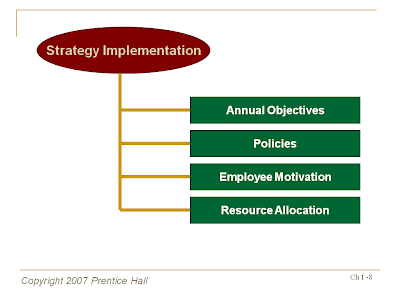Friday, 30 March 2012
The Strategic Model & The 3 Stages of SM
The Strategic Management Model
The framework illustrated by Fred David is a widely accepted, comprehensive model of the strategic-management process. This model does not guarantee success, but it does represent a clear and practical approach for formulating, implementing, and evaluating strategies. The strategic-management process is dynamic and continuous. A change in any one of the major components in the model can necessitate a change in any or all of the other components.
3 STAGES OF STRATEGIC MANAGEMENT
Strategy formulation includes developing a vision and mission, identifying an organization’s external opportunities and threats, determining internal strengths and weaknesses, establishing long-term objectives, generating alternative strategies, and choosing particular strategies to pursue.
Strategy implementation requires a firm to establish annual objectives, devise policies, motivate employees, and allocate resources so that formulated strategies can be executed; strategy implementation includes developing a strategy-supportive culture, creating an effective organizational structure, redirecting marketing efforts, preparing budgets, developing and utilizing information systems, and linking employee compensation to organizational performance.
Strategy evaluation is the final stage in strategic management. Managers desperately need to know when particular strategies are not working well; strategy evaluation is the primary means for obtaining this information.


